Table of Contents
Are you looking for something to elevate your product and its packaging to the next level? What if we told you that there is a type of packaging that elevates your brand’s presence on the shelves while also being functional for your products and sustainable for the environment? The packaging we’re referring to is custom pouches.
With the rise in demand for packaged food, businesses are increasingly adopting flexible packaging for their products that cater to cost-effectiveness, sustainability and aesthetic appeal. Pouches are just one type of flexible packaging that’s seen an increase in popularity in recent years, and for good reason.
Pouches are versatile for many industries, such as food, beverage, medical, pharmaceutical, cosmetics, and personal care, with MarketsandMarkets projecting stand-up pouches to dominate the pouch market from 2019 to 2024. Stand up pouches for food and drink, in particular, have seen a spike in demand due to their inherent synergies with the products and abundant benefits to the food industry. So, in this guide, we will cover everything you need to know before beginning your pouch packaging project!
1. Why Flexible Pouches? Understanding Their Benefits
The Flexible Packaging Association states that flexible packaging is one of the fastest-growing packaging industry sectors. Additionally, according to a 2023 industry report by GlobalData, businesses that switched to stand-up pouches reported a 25% increase in shelf impact and a 30% reduction in packaging costs.
Flexible packaging and, by extension, pouches packaging add value to food and non-food products by combining the best protective qualities of plastic, film, paper, and aluminum foil while using the least amount of materials. Pouches offer:
- Reduced Costs – Less material is used than traditional packaging, making pouch production more cost-effective.
- Enhanced Visibility and Aesthetic Appeal – A pouch’s ability to stand upright and its unique appearance give it a strong shelf presence.
- Convenience and Portability – Its lightweight and slim profile that takes up significantly less space when filled or unfilled helps reduce shipping costs and allows efficient storage and distribution. The Flexible Packaging Association equates one truckload of empty flexible pouches to 26 truckloads of empty glass jars.
- Extended Shelf Life for Your Products – Pouches come with barriers and special films that prevent external factors such as odours, oxygen, light, and bacteria from contaminating a product while keeping refrigerated items fresh for extended periods.
- Environmental Benefits – The Flexible Packaging Association revealed in a publication that flexible pouches use 75% less energy and generate a tenth of CO2 emissions during production than metal containers of equivalent products.
2. Premade vs. Custom Pouches – Which One is Right for You?
While the benefits mentioned above can extend to both custom and premade pouches, custom-made pouches offer so much more than stock pouches. Though premade pouches are lower in cost, customization is almost non-existent, a significant disadvantage to your brand in today’s market.
On the other hand, custom stand up pouches are designed from scratch to fit your product and branding requirements. The possibilities are endless, and at PakFactory, you can customize everything from the type of pouch to the materials, coating, layers and features. By developing a unique design that’s pleasing to the eye, convenient, and functional for customers, you are creating a positive image of your brand that will help distinguish you from the competition!
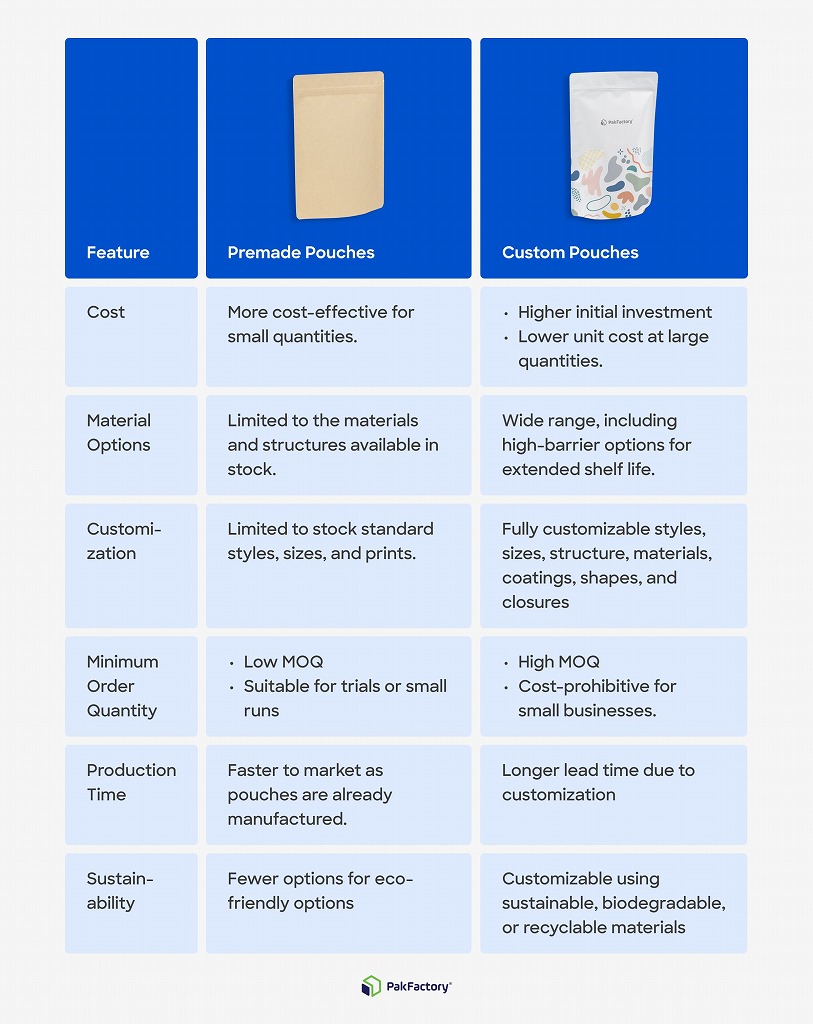
3. The Types of Pouches You Can Have
So, with custom pouches in mind, the first thing you can decide is the type of pouch you want for your product. Different pouches have their own set of benefits, but the ability to choose the one that best fits your product is another plus over premade pouches.
3.1 Stand-Up Pouches
Stand up pouch bags are ideal for storing and displaying foods or other retail products. They are one of the main go-to options for flexible packaging and are available in various sub-styles.
Block Bottom (Flat Bottom) Style
The block bottom bag, or flat bottom bag, is a pouch with a flat rectangular base that is sometimes gusseted on the sides, allowing it to stand upright. This pouch offers the maximum balance of stability and presence for your product as it can stand upright on the shelf, has good volume and space for heavier products and features 360 degrees of surface area for custom printing.
Block bottom bags are excellent for products such as coffee, pet food, spices, sweets, frozen foods, nutritional products, household chemicals and high-density products.

Bottom Gusset Style
Bottom gusset bags are a type of stand-up pouch with a rounded gusset bottom that allows the bag to stand independently without support. They are stronger and hold more weight than block bottom pouches. They are also generally larger than side gusset pouches, allowing more products to be packaged. This pouch type is flexible and suitable for many products, such as snacks, candy, coffee, baking powder, custards, liquids, hygiene products, and medical products.
The three main types of bottom gusset pouches available to you include;
- Plow-Bottom Pouch
- Doyen-Style Pouch
- K-Seal Stand Up Pouch (K-Style) with Skirt Seal
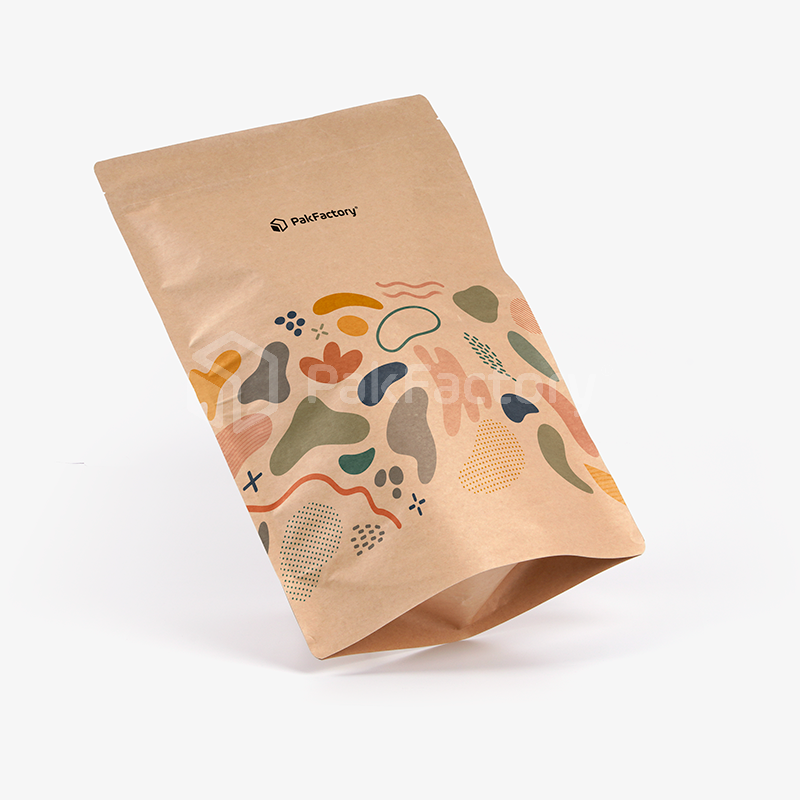
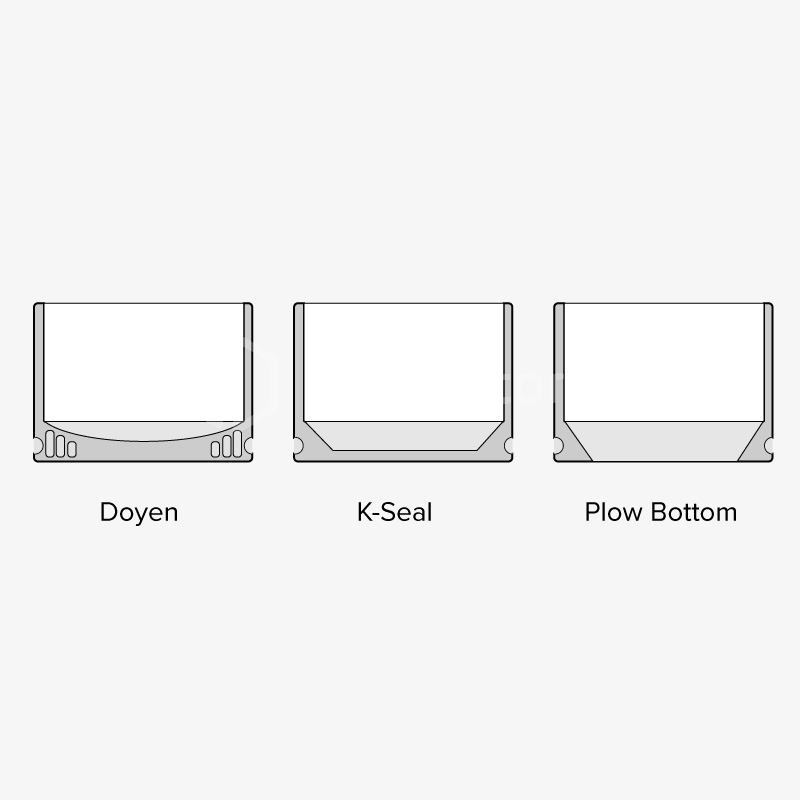
Side Gusset Style
The side gusset is the last sub-style of stand up pouches. As the name suggests, side gusset pouches feature gusseted sides and two flat panels on the front and back, making this style less box-shaped. Side gusset bags take up less space on the shelf but can still hold a good amount of product. Still, their smaller package size makes them more cost-effective, less wasteful, and perfect for storage.
Side gusset bags are popular for snacks, dry ingredients, frozen food, coffee and tea.
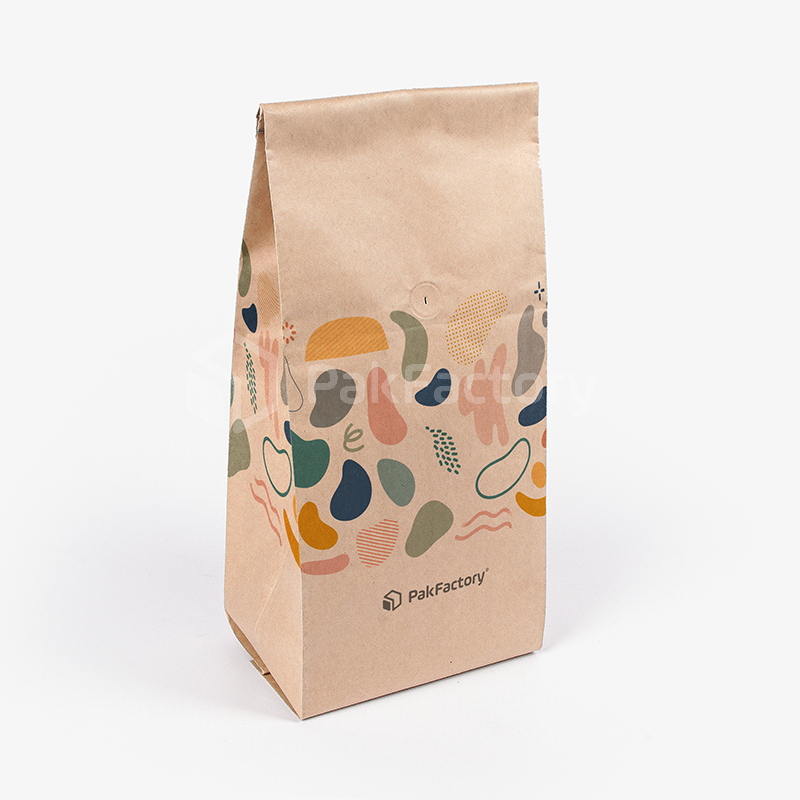
3.2 Flat Pouches
A flat pouch, or lay-flat pouch, is a style of flexible pouch packaging that is the most economical out of the other options we will cover in this guide. As the name suggests, lay-flat pouches are designed to lay on the shelf but still offer stability and a large printable surface for customization.
The three main styles available for flat pouches include;
Pillow Pouch Style
The pillow pouch packaging style is the most common type of flexible packaging. When filled, the pouch expands in the middle and flattens out at the top and bottom seals to resemble a pillow. Pillow pouches are cost-effective, use little space during storage and transport, allow for complete customization on the package’s front and back, and are ideal for single-serve products, snacks, frozen foods, and meal kits.
Pillow pouches also have other optional features, such as press-to-close zippers, hanger holes, product display windows, and tear notches.
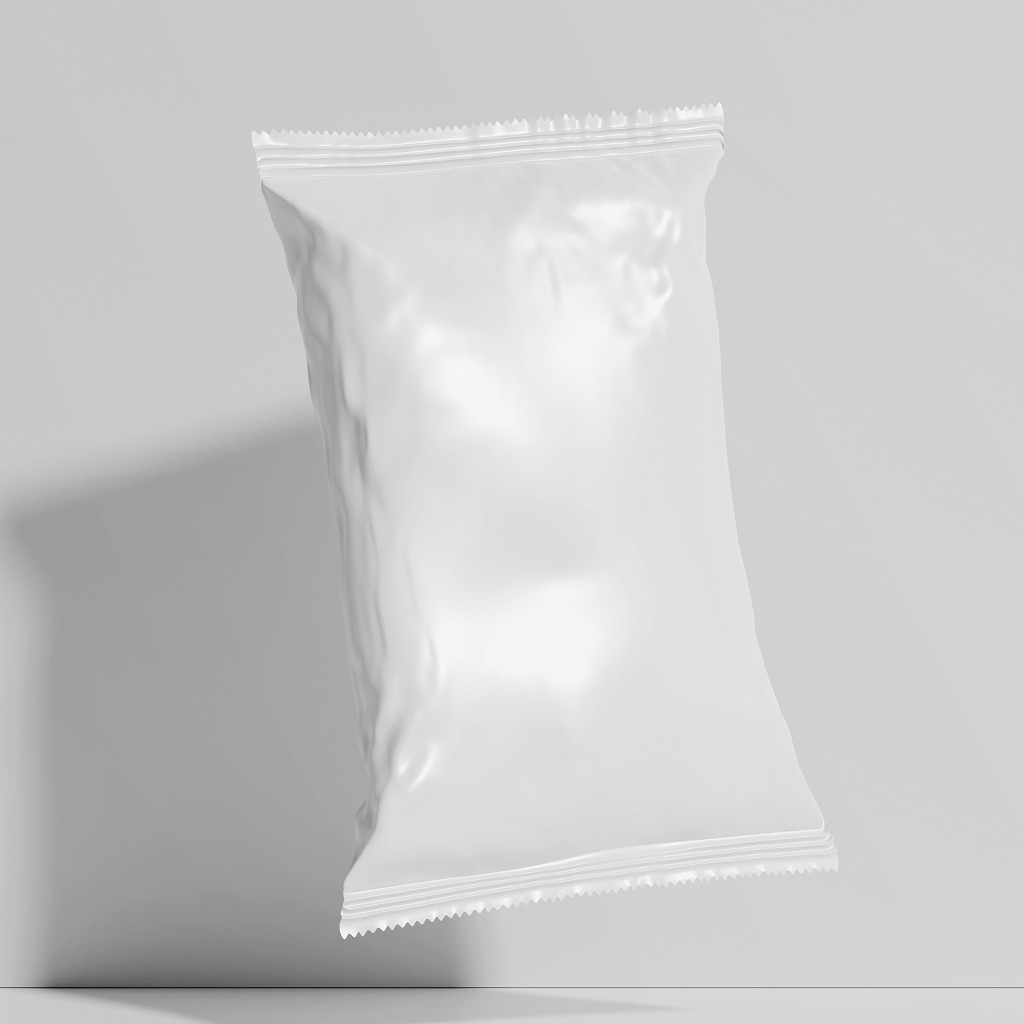
Three-Side Sealed Style
Three-sided sealed bags are similar to their four-sided cousin but are sealed on three sides and folded on one. The fold is generally featured on the bottom of the package to allow flexibility and the product to settle at the bottom of the bag, making this pouch ideal for ground products, coffee, snacks, spices, pet food, and produce.
A three-side sealed bag offers the same optional features as the other flat pouch styles while providing more bag volume than the four-side sealed bag and maintaining cost-effectiveness, efficient storage and transportation and good package uniformity for cartoning.
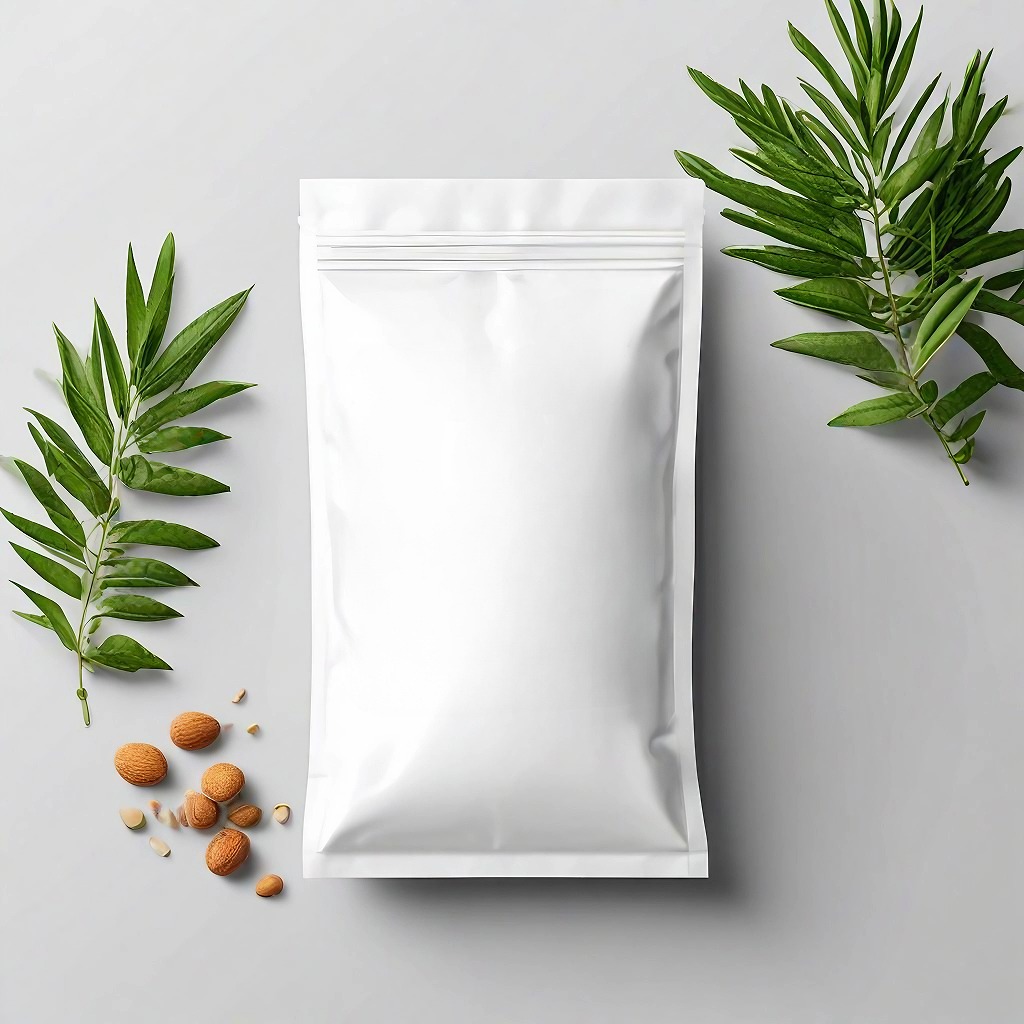
Four-Side Sealed Style
As the name suggests, a four-sided sealed bag is sealed on all sides to provide the best protection against leakage while still being customizable on the front and back panels. Unlike a pillow bag, this flat pouch cannot flex and expand as much, but it is a popular choice for liquid, medical, or sample products.
Four-sided sealed bags are also cost-effective, efficient to store and transport, and offer the same optional features as pillow bags.
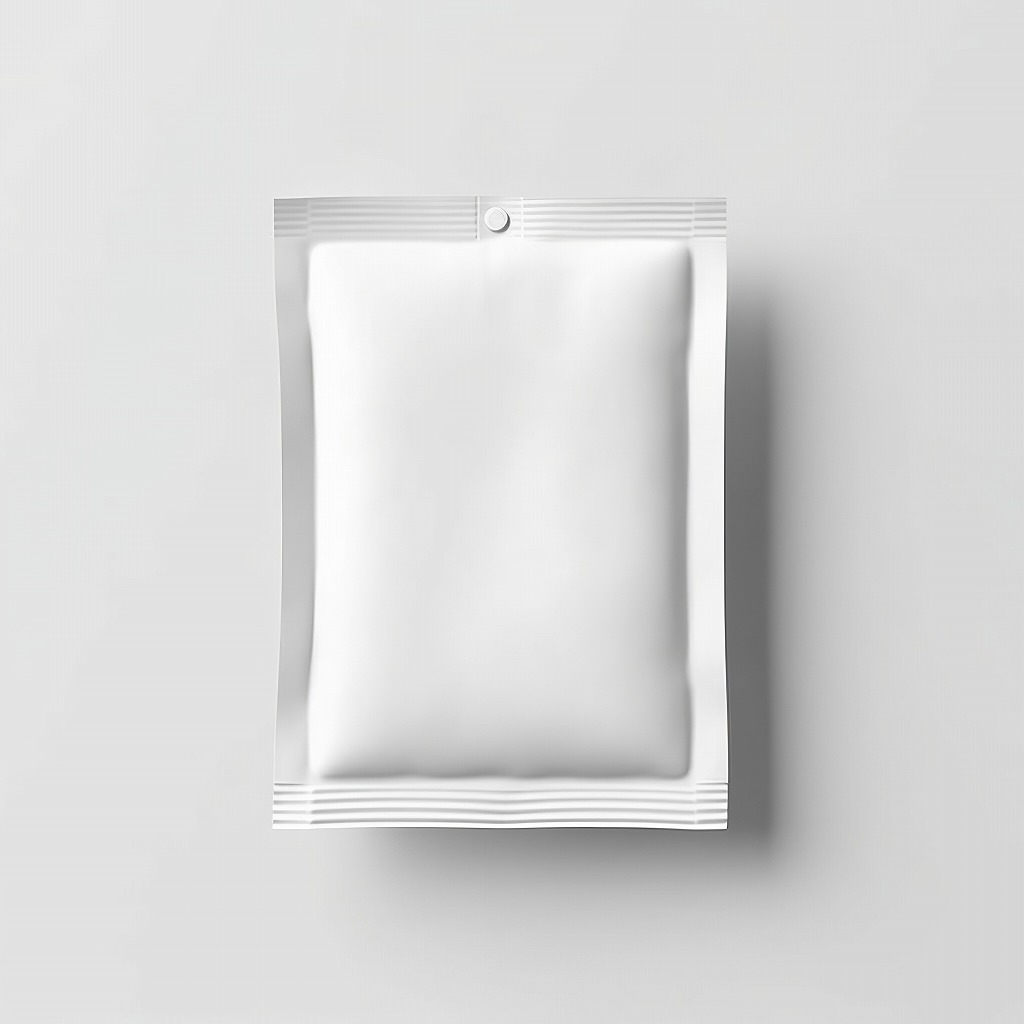
3.3 Roll Stock
Roll stock is a printed and laminated film on a roll that is then used with Form, Fill, Seal (FFS) machinery to form a package, fill it with a product, and seal it. This package option allows brands to create pouches using their own equipment, allowing for high speed and output over long runs.
Roll stock is perfect for smaller items such as nutrition bars, packaged snacks, single-serve samples and stick packs.
3.4 Custom Shaped Pouch
Custom shaped pouches offer the ultimate form of customization for your flexible packaging endeavors. If none of the above styles fit your brand’s identity, consider creating a shape that best suits you! Whether you are looking for a standing or flat pouch, you can always customize the bag to suit your desire. From the shape, size and openings to other optional features, a custom shaped pouch is guaranteed to elevate your packaging further.
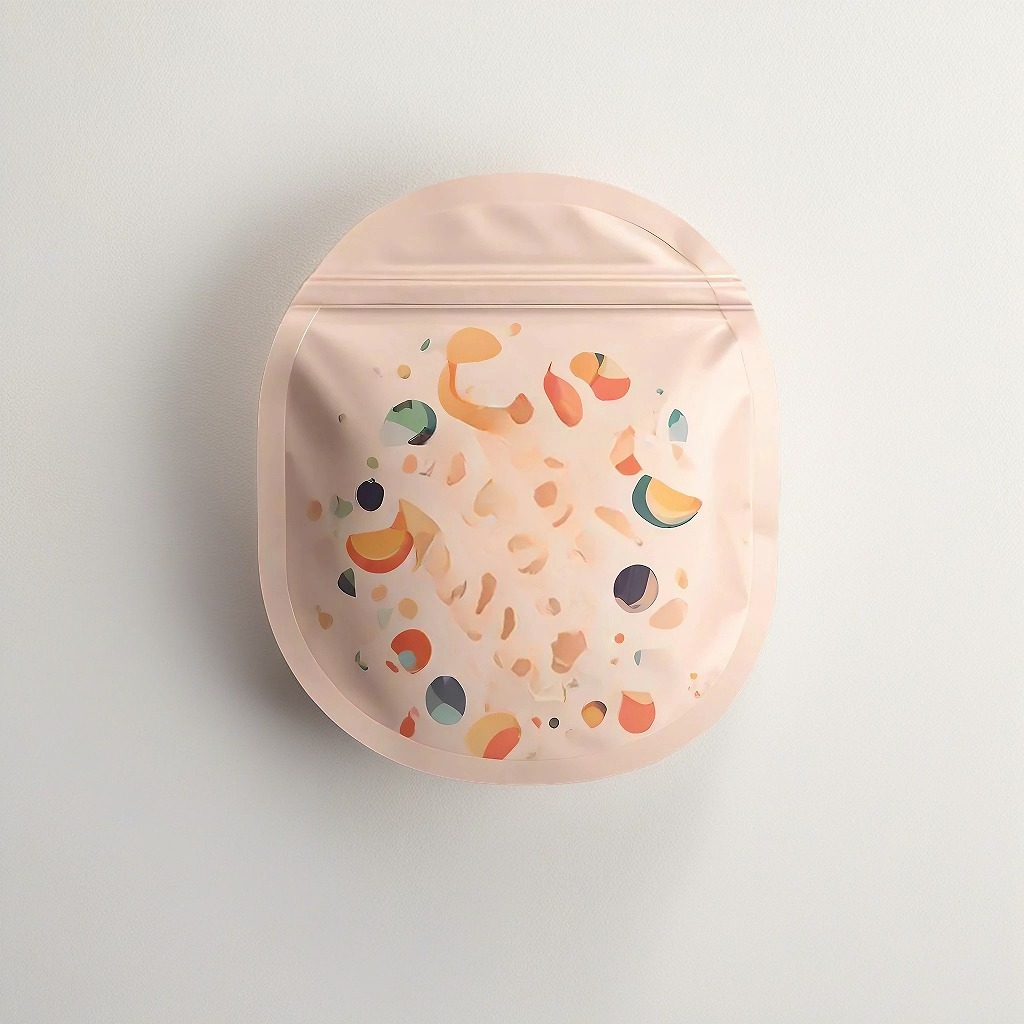
4. Choosing the Right Materials for Your Pouch
After deciding on the type of flexible pouch that fits your product, you need to consider the materials you want to use to create it. How pouches are made plays an equally crucial role in your packaging project as the type of pouch you choose, so it is worth considering all the options when making your decision. Some typical pouch materials used include plastic, metal foil, paper, and bioplastics.
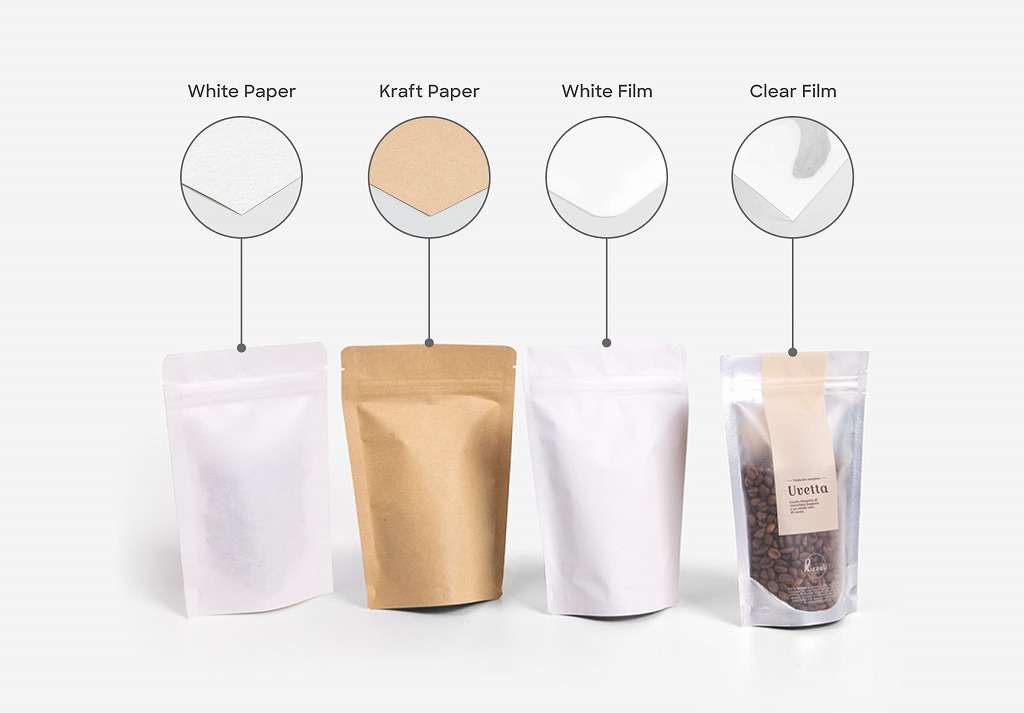
Plastic for Durability and Versatility
Plastic is an excellent barrier against contaminants like oxygen, moisture, dust and UV light. It helps maintain your product’s freshness and has good material qualities like rigidity, stability, flexibility, tensile strength and transparency.
However, plastic has a low melting point and cannot withstand high temperatures. It has a shorter life cycle than containers like glass or metal and is very environmentally harmful, with challenges related to waste, disposal, and recycling.
Plastic materials for pouches are typically made of;
- Polyethylene (PE)
- Nylon
- Polyethylene terephthalate (PET)
- High-density polyethylene (HDPE)
- Low-density polyethylene (LDPE)
- Cast polypropylene (OPP/CPP)
Metal Foil for Superior Barrier Protection
Metal foil provides maximum protection for your product against moisture, light, aromas, and oxygen, extending its shelf life. Foil packaging is durable, resistant to punctures and tears, and can withstand various temperatures.
However, it must be noted that foil still cannot be microwaved and is also harmful to the environment when improperly disposed of. Like plastic, it is non-biodegradable and can take hundreds of years to break down. In addition, foil is more expensive than other materials, such as paper and plastic.
Paper for a Natural Look and Sustainability
Paper materials are available in natural brown or white kraft. Unlike plastic and foil, kraft stand up pouches are naturally compostable while offering excellent barrier properties that protect a product from spills, pests, UV rays, oxygen, and moisture. Kraft paper also provides a high tensile strength, making the pouch resistant to punctures.
However, though kraft paper offers moisture protection, it still has poor water resistance and strength compared to other materials.
Bioplastics for Reduced Environmental Impact
Bioplastics are an environmental alternative to traditional plastics, offering similar protective properties while being less environmentally impactful. Made from plants or other biological materials like polylactic acid (PLA), bioplastic reduces carbon emissions by being biodegradable, breaking down naturally without releasing harmful chemicals. Bioplastics are also resealable, allowing the use of recyclable pouches to further contribute to a sustainable initiative.
However, though bioplastics seem to have all the benefits of plastic without the negatives, this is untrue. Bioplastics generally cost more—though their recyclability somewhat counteracts this—and sometimes have a shorter lifespan than traditional plastics, depending on the type of material used. Also, though bioplastics are biodegradable, they require special facilities and proper disposal to reduce pollution effectively.
5. Customization Options for Your Pouches
We briefly mentioned the optional customization earlier in this guide, but more than a brief mention is needed to show you the breadth of what you can do with a custom pouch. Pouches feature many customizable options, such as various fitments, closures, merchandising features, layers, and shapes.
Fitments and Closures
The first type of customization we will look at are the fitments and closures. These customizations contribute to the longevity of your product by determining how the pouch dispenses your product and whether it can be closed again. Popular options include;
- Easy dispensing pouches with a tear notch are ideal for liquid, gel or lotion samples.
- A Tear Notch or slit is a perforated top that allows for an easy opening process. You can also feature tear notches with other options like zippers for resealability.
- Press-to-close zippers are an excellent and cost-effective option that allows your pouch to be conveniently closed and reopened.
- Sliders are easy and fast to open and reclose. They offer your consumers the convenience and assurance that the pouch is closed correctly.
- A Spout Pouch features a re-closable nozzle for easy access to liquid products.
- Resealable films allow consumers to open and reseal a pouch using tamper-evident methods for safety and convenience.
- A degassing valve is excellent for products like coffee that use stand-up pouches. The one-way valve vents CO2, allowing products to stay fresh for longer.
- Tin ties add a quick way for consumers to close a pouch and are popular for baked goods.
Merchandising Features
These customization options help display your pouch on store shelves and attract potential customers with convenient additions to your packaging. Options include;
- Hang/Peg holes that enable a pouch to be placed on hangars or hooks.
- Display Windows on a stand-up pouch lets consumers see the product inside the package.
- Carry-hole handles provide an accessible and comfortable place for customers to carry a pouch bag without worrying about dropping it.
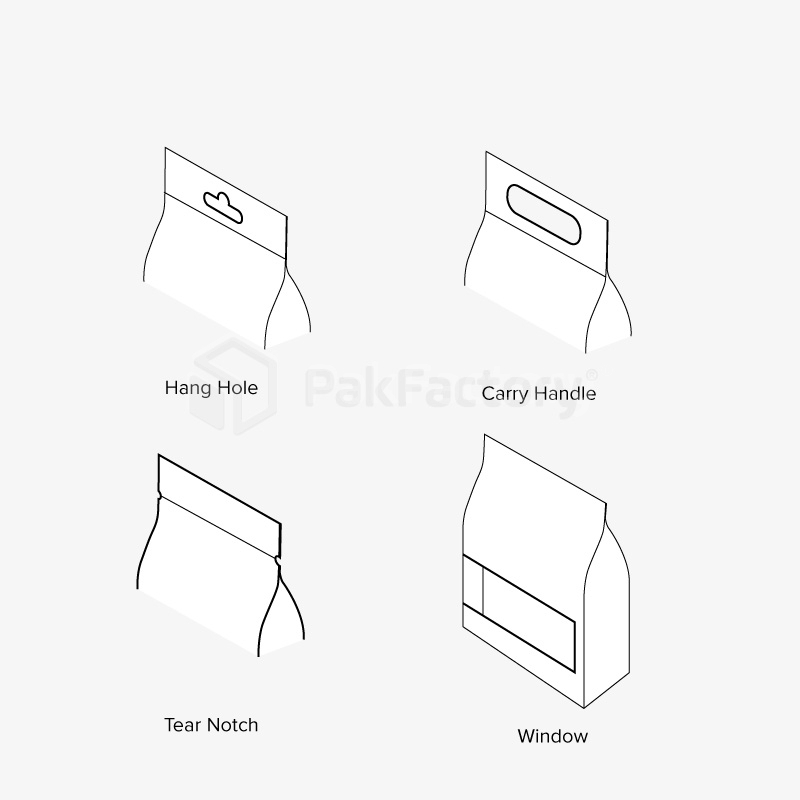
Barriers and Coatings
Barrier and coating layers come in direct contact with the product and protect the pouch and its contents against contaminants by providing crucial barrier properties. These customizations improve packaging integrity and structure while increasing shelf life and preventing food waste. Barrier properties for stand-up and flat barrier pouches include;
- Moisture Protection prevents food from losing moisture or protects against moisture for dry foods.
- Grease Resistance/Grease-Proofing protects the package and maintains hygiene by resisting grease transfer from product to package.
- Gas and Aroma Barriers prevent contaminants such as oxygen from entering a package and causing spoilage or prevent gasses from escaping.
- Additional Heat Resistance gives a pouch extra resistance against hotter temperatures.
Typical coating materials to achieve the above barrier properties include aluminum foil, EVOH resin, transparent film, nylon, polyethylene terephthalate (PET), polyethylene (PE), and breathable or permeable barriers.
Material Structures and Layers
Pouches typically have multiple layers of material structure, all of which can be customized for different functions to market, protect, and preserve a product. Layers include;
- The print/ink and coating layer is the outermost layer used for branding and design. It affects a package’s overall look and feel while providing product information to consumers.
- Structural layers give a pouch its strength, durability and puncture resistance.
- Barrier layers protect a product from odor, oxygen, light, and bacteria.
- Sealant layers protect from leaks and provide functionality for other customizations like closures, fitments and resealability.
- Tie layers are what bond structural and barrier layers together.
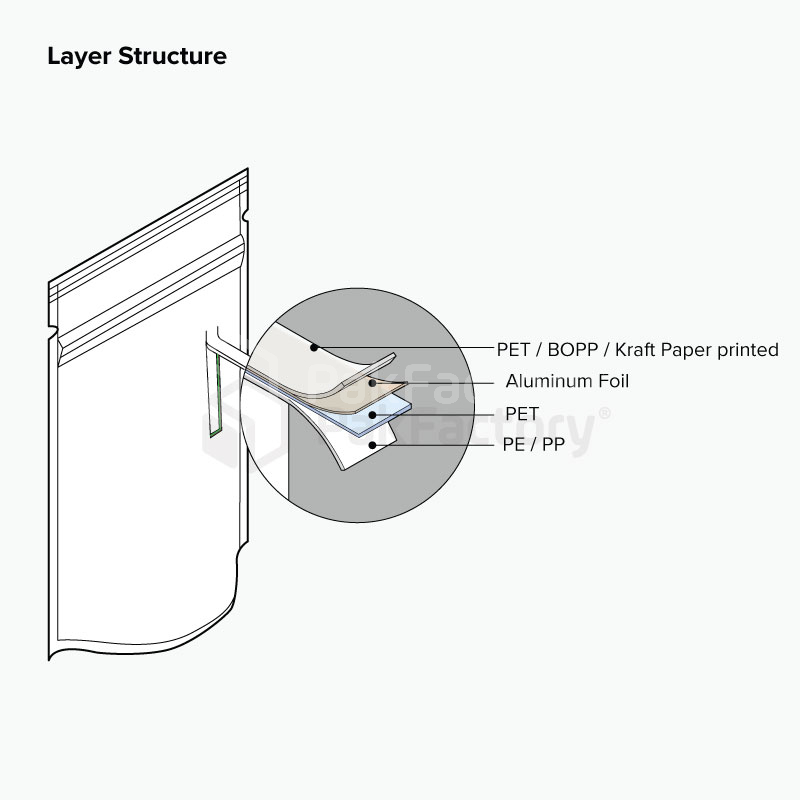
6. Pouch Treatment and Filling Methods
With your packaging customized to your liking, it’s time to consider one of the most crucial factors in your pouch packaging endeavor: how to fill stand-up pouches.
Not only do different treatment and packaging techniques contribute to your product’s ability to maintain taste and freshness while having an optimal shelf life, but they are also crucial to meeting safety, compliance, and quality standards established by regulatory bodies like the FDA.
Standards for product sterility, sterile zones in the manufacturing process, packaging systems, materials and more are all requirements, so carefully considering your treatment and filling methods and ensuring they meet FDA or other regulatory body standards is essential. Common filling and treatment methods include;
Manual Filling
The most basic and generally low-cost method of filling involves using a scoop or similar tool to fill a pouch by hand. The bag is then manually sealed using impulse heat-sealing or direct heat-sealing equipment. Manual filling allows greater control over quantity and quality but may only be suitable for small-scale operations or starting businesses, as this is far from ideal at larger scales.
Aseptic Packaging
Aseptic packaging is the typical method used in the food and pharmaceutical industry. The product is sterilized through quick exposure to high heat in a technique known as flash pasteurization and then rapidly cooled to room temperature. The product is then filled into sterilized pouches and sealed in a sterile environment, enabling the packaged contents to last up to 18 months.
Ideal applications for aseptic filling include liquid pouch packaging for milk or high-acid products such as juices in glass, aluminum or PET containers.
Retort Packaging
The retort-filling method involves filling a package with a non-sterile product and sealing it in a non-sterile, retort-able flexible pouch with heat-resistant plastic layers that can withstand high temperatures with or without aluminum foil so the product can be thermo-processed. The retort pouches are then loaded into a retort pressure chamber and sterilized with heated pressurized steam.
Retort pouch packaging is ideal for foods with a pH level greater than or equal to 4.5, such as chicken breasts, chili, ham, and tuna.
Hot-Filled
The hot-filling process involves sterilizing a product through high heat before filling it into a non-sterile container and immediately cooling it to preserve taste and quality. Opposite to retort packaging, hot-filling is suitable for foods with a pH lower than 4.5 and is also cost-effective for various liquids, including soft drinks, non-carbonated beverages, juices, water, and teas.
7. Printing Techniques for Your Custom Pouch
The design and print are the final things to consider when planning your pouch project. Depending on the purpose, budget, and type of finish you are looking for, one technique might better suit your needs than the others.
But before we discuss the various techniques available to you, it is important to note that color matching with packages involving two or more components of different materials may be difficult regardless of your chosen printing technique. So, with this in mind, let’s look at the various other pros and cons each printing technique offers.
Flexography Printing
Flexography is the most commonly used technique for pouch printing and works very well on pouches made of kraft material. It involves rolling the pouch through a printing press and then pulling it into several printing units. Flexography is best for larger runs, as it has high setup costs but has the lowest cost per unit among the other printing options. It offers minimal coloring and lower print qualities unsuitable for photo images but excellent for simple designs and a quick turnaround time.
Rotogravure Printing
This printing method works well on a wide selection of materials and involves engraving the image design on multiple color plates and transferring it onto the pouch. Like flexography, rotogravure is best for larger runs with a high setup cost and a lower cost per unit. However, unlike flexography, rotogravure offers crisper colors and exceptional image quality.
Digital Printing
The digital printing method involves printing digital-based images directly onto the pouch. This technique is best for smaller runs and dynamic content like special promotions and serialization as it has no setup costs but a higher price per unit. Digital printing offers the fastest turn-around time while having a high print quality and can be used on most materials.
8. Looking for a Custom Pouch Packaging Partner?
Although this guide contains many factors to consider and may be overwhelming, they are all equally essential to a successful custom pouch project. However, you do not have to work alone. Whether you are looking for more help, are ready to find a pouch packaging manufacturer or partner, or want to jump right in and order custom pouches, PakFactory is the choice for you.
Don’t believe us? Check out some of our previous designs for pouches and get inspired!





